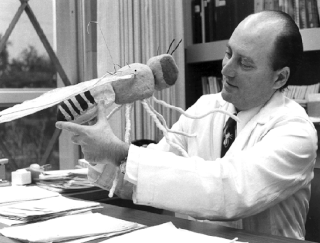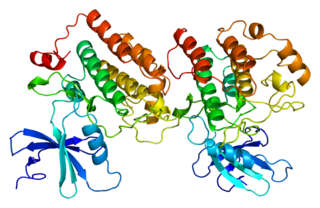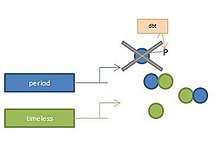
A circadian rhythm, or circadian cycle, is a natural oscillation that repeats roughly every 24 hours. Circadian rhythms can refer to any process that originates within an organism and responds to the environment. Circadian rhythms are regulated by a circadian clock whose primary function is to rhythmically co-ordinate biological processes so they occur at the correct time to maximise the fitness of an individual. Circadian rhythms have been widely observed in animals, plants, fungi and cyanobacteria and there is evidence that they evolved independently in each of these kingdoms of life.

Seymour Benzer was an American physicist, molecular biologist and behavioral geneticist. His career began during the molecular biology revolution of the 1950s, and he eventually rose to prominence in the fields of molecular and behavioral genetics. He led a productive genetics research lab both at Purdue University and as the James G. Boswell Professor of Neuroscience, emeritus, at the California Institute of Technology.
A circadian clock, or circadian oscillator, also known as one’s internal alarm clock is a biochemical oscillator that cycles with a stable phase and is synchronized with solar time.
The Casein kinase 1 family of protein kinases are serine/threonine-selective enzymes that function as regulators of signal transduction pathways in most eukaryotic cell types. CK1 isoforms are involved in Wnt signaling, circadian rhythms, nucleo-cytoplasmic shuttling of transcription factors, DNA repair, and DNA transcription.

CLOCK is a gene encoding a basic helix-loop-helix-PAS transcription factor that is known to affect both the persistence and period of circadian rhythms.
Timeless (tim) is a gene in multiple species but is most notable for its role in Drosophila for encoding TIM, an essential protein that regulates circadian rhythm. Timeless mRNA and protein oscillate rhythmically with time as part of a transcription-translation negative feedback loop involving the period (per) gene and its protein.
Period (per) is a gene located on the X chromosome of Drosophila melanogaster. Oscillations in levels of both per transcript and its corresponding protein PER have a period of approximately 24 hours and together play a central role in the molecular mechanism of the Drosophila biological clock driving circadian rhythms in eclosion and locomotor activity. Mutations in the per gene can shorten (perS), lengthen (perL), and even abolish (per0) the period of the circadian rhythm.
In molecular biology, an oscillating gene is a gene that is expressed in a rhythmic pattern or in periodic cycles. Oscillating genes are usually circadian and can be identified by periodic changes in the state of an organism. Circadian rhythms, controlled by oscillating genes, have a period of approximately 24 hours. For example, plant leaves opening and closing at different times of the day or the sleep-wake schedule of animals can all include circadian rhythms. Other periods are also possible, such as 29.5 days resulting from circalunar rhythms or 12.4 hours resulting from circatidal rhythms. Oscillating genes include both core clock component genes and output genes. A core clock component gene is a gene necessary for to the pacemaker. However, an output oscillating gene, such as the AVP gene, is rhythmic but not necessary to the pacemaker.
Ronald J. Konopka (1947-2015) was an American geneticist who studied chronobiology. He made his most notable contribution to the field while working with Drosophila in the lab of Seymour Benzer at the California Institute of Technology. During this work, Konopka discovered the period (per) gene, which controls the period of circadian rhythms.

Cycle (cyc) is a gene in Drosophila melanogaster that encodes the CYCLE protein (CYC). The Cycle gene (cyc) is expressed in a variety of cell types in a circadian manner. It is involved in controlling both the sleep-wake cycle and circadian regulation of gene expression by promoting transcription in a negative feedback mechanism. The cyc gene is located on the left arm of chromosome 3 and codes for a transcription factor containing a basic helix-loop-helix (bHLH) domain and a PAS domain. The 2.17 kb cyc gene is divided into 5 coding exons totaling 1,625 base pairs which code for 413 aminos acid residues. Currently 19 alleles are known for cyc. Orthologs performing the same function in other species include ARNTL and ARNTL2.
Doubletime (DBT), also known as discs overgrown (DCO), is a gene that encodes the doubletime protein in fruit flies. Michael Young and his team at Rockefeller University first identified and characterized the gene in 1998.

Michael Morris Rosbash is an American geneticist and chronobiologist. Rosbash is a professor and researcher at Brandeis University and investigator at the Howard Hughes Medical Institute. Rosbash's research group cloned the Drosophila period gene in 1984 and proposed the Transcription Translation Negative Feedback Loop for circadian clocks in 1990. In 1998, they discovered the cycle gene, clock gene, and cryptochrome photoreceptor in Drosophila through the use of forward genetics, by first identifying the phenotype of a mutant and then determining the genetics behind the mutation. Rosbash was elected to the National Academy of Sciences in 2003. Along with Michael W. Young and Jeffrey C. Hall, he was awarded the 2017 Nobel Prize in Physiology or Medicine "for their discoveries of molecular mechanisms controlling the circadian rhythm".

Jeffrey Connor Hall is an American geneticist and chronobiologist. Hall is Professor Emeritus of Biology at Brandeis University and currently resides in Cambridge, Maine.

Casein kinase I isoform epsilon or CK1ε, is an enzyme that is encoded by the CSNK1E gene in humans. It is the mammalian homolog of doubletime. CK1ε is a serine/threonine protein kinase and is very highly conserved; therefore, this kinase is very similar to other members of the casein kinase 1 family, of which there are seven mammalian isoforms. CK1ε is most similar to CK1δ in structure and function as the two enzymes maintain a high sequence similarity on their regulatory C-terminal and catalytic domains. This gene is a major component of the mammalian oscillator which controls cellular circadian rhythms. CK1ε has also been implicated in modulating various human health issues such as cancer, neurodegenerative diseases, and diabetes.
Amita Sehgal is a molecular biologist and chronobiologist in the Department of Neuroscience at the Perelman School of Medicine at the University of Pennsylvania. Sehgal was involved in the discovery of Drosophila TIM and many other important components of the Drosophila clock mechanism. Sehgal also played a pivotal role in the development of Drosophila as a model for the study of sleep. Her research continues to be focused on understanding the genetic basis of sleep and also how circadian systems relate to other aspects of physiology.
Jeffrey L. Price is an American researcher and author in the fields of circadian rhythms and molecular biology. His chronobiology work with Drosophila melanogaster has led to the discoveries of the circadian genes timeless (tim) and doubletime (dbt), and the doubletime regulators spaghetti (SPAG) and bride of doubletime (BDBT).
Paul Hardin is an American scientist in the field of chronobiology and a pioneering researcher in the understanding of circadian clocks in flies and mammals. Hardin currently serves as a distinguished professor in the biology department at Texas A&M University. He is best known for his discovery of circadian oscillations in the mRNA of the clock gene Period (per), the importance of the E-Box in per activation, the interlocked feedback loops that control rhythms in activator gene transcription, and the circadian regulation of olfaction in Drosophila melanogaster. Born in a suburb of Chicago, Matteson, Illinois, Hardin currently resides in College Station, Texas, with his wife and three children.

Drosophila circadian rhythm is a daily 24-hour cycle of rest and activity in the fruit flies of the genus Drosophila. The biological process was discovered and is best understood in the species Drosophila melanogaster. Other than normal sleep-wake activity, D. melanogaster has two unique daily behaviours, namely regular vibration during the process of hatching from the pupa, and during mating. Locomotor activity is maximum at dawn and dusk, while eclosion is at dawn.
dClock (clk) is a gene located on the 3L chromosome of Drosophila melanogaster. Mapping and cloning of the gene indicates that it is the Drosophila homolog of the mouse gene CLOCK (mClock). The Jrk mutation disrupts the transcription cycling of per and tim and manifests dominant effects.
Ravi Allada is an Indian-American chronobiologist studying the circadian and homeostatic regulation of sleep primarily in the fruit fly Drosophila. He is currently the Executive Director of the Michigan Neuroscience Institute (MNI), a collective which connects neuroscience investigators across the University of Michigan to probe the mysteries of the brain on a cellular, molecular, and behavioral level. Working with Michael Rosbash, he positionally cloned the Drosophila Clock gene. In his laboratory at Northwestern, he discovered a conserved mechanism for circadian control of sleep-wake cycle, as well as circuit mechanisms that manage levels of sleep.









